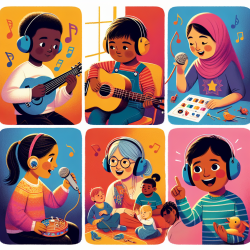Introduction
In the realm of special education and speech therapy, understanding the nuances of emotional prosody in children with cochlear implants (CIs) is vital. A recent study titled "Child implant users' imitation of happy- and sad-sounding speech" provides insights into how these children perceive and produce emotional speech. This research is crucial for practitioners aiming to enhance their therapeutic interventions.
Understanding the Research
The study compared the ability of children with cochlear implants to imitate happy and sad speech with that of their normally hearing (NH) peers. It was found that while both groups could differentiate between happy and sad prosody, NH children performed better in imitating these emotional cues. The study highlights the challenges CI users face due to the degraded spectral input provided by their devices, which affects their perception of pitch and, consequently, emotional speech.
Key Findings and Implications
- Children with CIs produced less accurate imitations of happy and sad prosody compared to NH children.
- Both groups struggled more with happy utterances due to their greater pitch modulation.
- Therapeutic interventions should expand their focus on the suprasegmental aspects of speech, particularly intonation patterns.
The study suggests that focusing on emotional expressiveness in therapeutic settings could significantly benefit CI users. By enhancing their ability to perceive and produce emotional prosody, practitioners can help improve the communicative competence of these children.
Practical Applications for Practitioners
For practitioners working with CI users, incorporating exercises that emphasize pitch variation and intonation can be beneficial. Here are some strategies to consider:
- Imitation Exercises: Encourage children to imitate sentences with varying emotional tones, focusing on pitch and modulation.
- Music Integration: Utilize music therapy to improve pitch perception and production. Studies have shown that music lessons can enhance linguistic abilities in children.
- Prosody-Focused Activities: Design activities that specifically target the recognition and production of emotional prosody.
Encouraging Further Research
While this study provides valuable insights, there is a need for further research to explore long-term outcomes of enhanced prosody-focused interventions. Practitioners are encouraged to contribute to this field by conducting longitudinal studies and sharing their findings.
Conclusion
Understanding and improving the emotional prosody of children with cochlear implants is crucial for their social and communicative development. By implementing the findings of this research, practitioners can make significant strides in enhancing the quality of life for these children.
To read the original research paper, please follow this link: Child implant users' imitation of happy- and sad-sounding speech.










